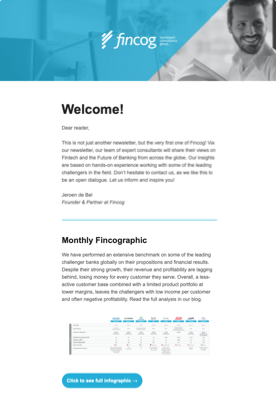As part Fincog’s series of podcast for our Future of Banking report we spoke to Jan van Vonno, from Tink. Our report outlines the recent trends and dynamics across markets and thereby provides an outlook on the future financial services market and how banks can best respond to the new reality of banking.
Jan is the Head of Strategy at Tink and works closely with industry bodies and customers across Europe. He shares with us his insights on the future of the payments and open banking.
Q. What does open banking mean to you?
We define open banking as the exchange of data and services between financial institutions and third-party providers to deliver enhanced capabilities and experiences to the market. What does that mean? That means that any type of exchange, whether that is through an open API, or a private API could be a form of open banking, and as such that means that there are different types of open banking business models.
Q. Some people say that open banking hasn't yet shown its full potential. What do you think has been the impact so far and what will the long-term impact of open banking be?
Since 2018 the number of open banking providers in Europe has increased from 114 to 554 licensed institutions. There has been a massive acceleration in the adoption of open banking technologies and, in parallel, pretty much every single bank in Europe has created and issued or published dedicated interfaces. In other words, there are two APIs that allow more than 500 institutions connect to create value for their market.
Q. You have said that the adoption of open banking is already here, and we are using it in our daily lives without even knowing it.
Yes, absolutely. In fact, the most common payment method in the Dutch market – iDeal – is classified as open banking. What you're essentially doing is authorizing iDeal to execute or initiate a transaction on your behalf. The only nuance between PSD2 payment initiation services and iDeal is that iDeal comes from the pre-PSD2 market.
Q. Open banking is not a new concept, but we are seeing its standardization and advancement, notably in the EU with PSD2. Can you tell us about PSD2’s objectives?
PSD2 really has three objectives: to drive innovation, competition, and increase consumer protection. Now, while it has increased consumer protection by enforcing strong customer authentication for any payment that is executed, the driving of competition and innovation are areas where arguably there could have been more achieved and there could have been better effort.
Q. What has your experience been in terms of the implementation of open banking?
Banks have massively underestimated the complexities involved in creating a dedicated interface such as the ones that we've been using in the world of PSD2. However, we have also seen much collaboration and cooperation. Our ability to connect to over 3,500 banks across 18 European markets allows us to have a good understanding in terms of what best practices are and what loose ends need to be tied to make sure that there is a compelling user journey for such open banking processes. I think banks intend to create compelling services because at the end of the day, the biggest risk for them is to lose face with their own customers when the experience is bad.


